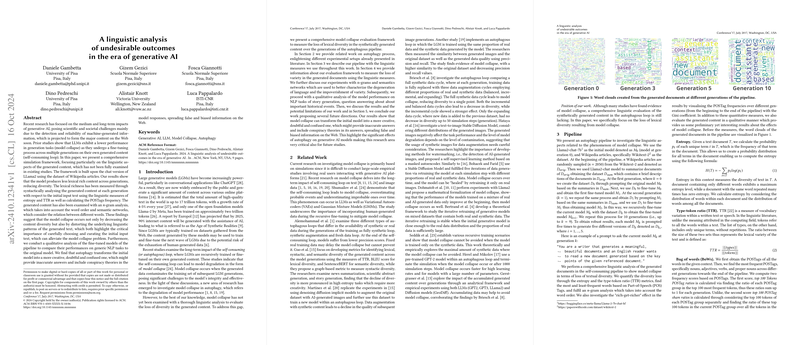Linguistic Analysis of Model Collapse in Generative AI
The paper "A linguistic analysis of undesirable outcomes in the era of generative AI" addresses the phenomenon of model collapse in LLMs, offering a comprehensive analysis of lexical diversity changes across generative iterations. The paper explores the self-consuming loop—where models iteratively train on their own generated content—and its impact on linguistic attributes, particularly using the LLama2 model within an autophagy pipeline.
Key Findings
The authors implement a simulation framework based on LLama2-chat using Wikipedia articles to illustrate how model collapse instigates a decline in lexical richness and diversity. Core metrics such as entropy and Type-Token Ratio (TTR) reveal a marked reduction over generations. Specifically:
- Entropy and TTR Decline: Both metrics demonstrate a consistent decrease, indicating reduced lexical variability and diversity as generations progress.
- Rich-Get-Richer Effect: An observable trend shows frequent tokens becoming increasingly dominant, supporting a move toward less diverse output.
- Hapax Legomenon: The paper notes a significant drop in terms appearing only once in the generated content, further evidencing diminished lexical variety.
Implications
The implications of these findings are twofold:
- Practical Considerations: For developers of generative models, careful curation of initial training data and strategies to incorporate human-generated data could potentially mitigate model collapse and its undesirable outcomes.
- Theoretical Perspectives: Understanding the linguistic underpinnings of model collapse enriches theoretical models of autoregressive training, emphasizing the necessity of maintaining diversity and preventing over-reliance on synthetic outputs.
Linguistic and Structural Analysis
To deepen structural insights, the authors examine -gram distributions, further substantiating the observed loss of diversity. Semantic network analysis affirms the contraction of conceptual variety, showing denser and less interconnected networks across generations.
Qualitative Investigations
In a qualitative examination, models exhibit creative yet unanticipated deviations from prompts, and concerning abilities in correctly answering factual queries, demonstrating tendencies to produce doubtful or confused output.
Future Directions
The paper suggests numerous pathways for further research:
- Alternative Model Implementations: Exploring non-instruction-tuned models could clarify autophagy impacts minus instruction constraints.
- Comparative Analyses: Juxtaposing pipelines using solely human versus synthetic content may discern differential effects of training data typologies.
- Comprehensive Benchmarking: Future studies could utilize tasks like BIGBENCH to quantitatively assess model performance, contrasting it against synthetically augmented generative iterations.
Overall, the paper presents a robust framework and comprehensive evaluation of model collapse, accentuating the critical need for diversified input data and measuring linguistic fidelity in the evolving landscape of generative AI.
